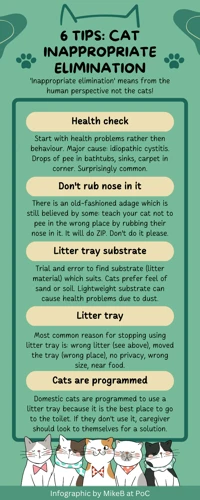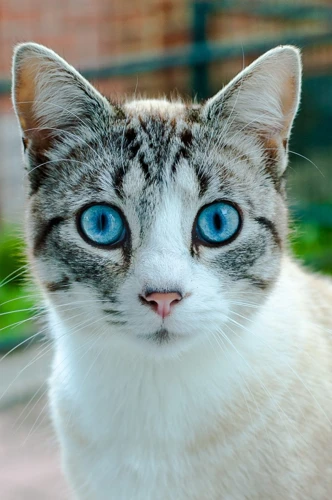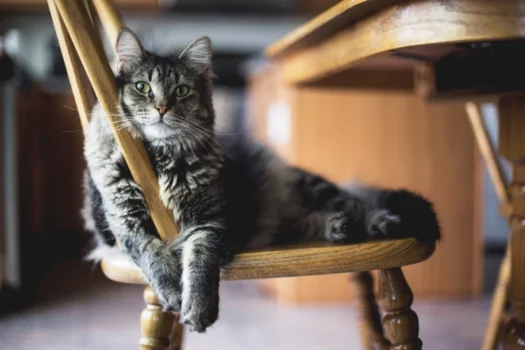Have you noticed that your California Spangled is not using their litter box properly? Dealing with litter box issues can be frustrating, but it’s important to identify the root cause and address it promptly to ensure your cat’s well-being and maintain a clean household. In this article, we’ll explore some common litter box problems and solutions, as well as tips to encourage litter box usage. Plus, we’ll discuss when it’s necessary to seek the advice of a veterinarian. Let’s dive in and help your California Spangled become a litter box pro.
Common Litter Box Problems and Solutions

As a California Spangled cat owner, it’s crucial to keep an eye on your furry friend’s litter box habits. Litter box problems are frustrating and can lead to undesirable messes around your home. However, there are ways to prevent and solve these issues. In this section, we will discuss some of the most common litter box problems and offer practical solutions. By the end of this section, you’ll have a better understanding of how to troubleshoot these problems and keep your feline friend happy. And for more information on house training your California Spangled cat, check out our guide to house training your California Spangled cat.
1. Wrong Type of Litter
One common issue that many California Spangled cat owners face is their cat not using the litter box properly. One of the reasons for this problem could be the wrong type of litter. It is important to use the right type of litter that your cat will be comfortable using.
Some litters may have a texture or odor that may not appeal to your California Spangled, and this can make them avoid using the litter box altogether. When choosing litter for your cat, consider their preferences, and try out different litters before settling on one that your cat is comfortable with.
There are various types of litter available on the market, including clay, silica gel, recycled paper, pine, and wheat. Clumping litter is one of the most common types of litter used for cats as it is easy to clean; however, it may not be suitable for all cats as some may ingest it, leading to health problems. Consider choosing litter that is safe and comfortable for your cat to use.
It is also important to avoid scented litters as they may be irritating to your cat’s sensitive sense of smell. If your cat has a problem with the type of litter that you are using, consider gradually transitioning to a different type of litter that they will use.
By choosing the right type of litter for your California Spangled, you can help encourage proper litter box usage and reduce any problems that may arise due to discomfort or irritation caused by the wrong type of litter.
2. Dirty Litter Box
One of the most common reasons why a California Spangled may stop using their litter box is due to it being unclean. Cats are known for their fastidiousness, and will not use a dirty litter box. It’s essential to keep the litter box clean. A dirty litter box can lead to infections, and your cat may refuse to use it, which can cause a lot of stress for both the cat and the owner.
To keep the litter box clean, it’s essential to scoop the box daily. The frequency will depend on how many cats you have and how often they use the litter box. As a general rule, one litter box per cat is recommended, and the boxes should be scooped at least once a day.
In addition to scooping, regular cleaning is also crucial. You should do a complete litter box change at least once a week, washing it with soap and water, and adding new litter. If the litter box is visibly soiled, it’s best to do the change more frequently.
Here are some tips to keep the litter box clean and reduce unpleasant odors in your home:
| Tip | Description |
|---|---|
| Use a litter mat | A litter mat can help catch excess litter, reducing mess and making clean-up easier. |
| Use unscented litter | Cats have a very sensitive sense of smell, and scented litter can be overwhelming for them. It’s best to stick to unscented litter. |
| Use a litter box liner | Liners can make it easier to clean the litter box and reduce odors. However, if your cat has a habit of scratching at the liner, it may be best to avoid it. |
| Replace the litter box if necessary | If the litter box is old and worn out, it may be best to replace it. Over time, bacteria can build up in the plastic, making it hard to keep clean. |
By following these tips, you can ensure that your California Spangled has a clean litter box, reducing the chances of them developing medical problems and litter box problems. If your cat continues to refuse to use the litter box even after it’s been cleaned regularly, it’s best to seek advice from a veterinarian.
3. Inaccessible Litter Box
One common reason a California Spangled might have litter box problems is if the litter box is inaccessible to them. This could be due to the box being placed in an area that the cat cannot reach, or if the sides of the litter box are too high for the cat to comfortably climb in and out of. A tall cat with mobility issues or a kitten that is too small might struggle with high sides.
To ensure that the litter box is accessible, choose a box with low sides or consider purchasing a litter box ramp. These ramps are designed to help cats climb into the litter box, making it easy and accessible for them. Additionally, make sure the litter box is placed in an area where the cat can easily access it without having to jump or climb stairs.
Another option is to provide multiple litter boxes throughout the house, especially if you have a large home. This will ensure that your California Spangled always has access to a litter box no matter where they are in the house.
It’s important to keep in mind that cats are creatures of habit and can become stressed or anxious if their litter box is moved or inaccessible. It’s important to keep the litter box in a consistent location to avoid confusing your cat and causing litter box problems.
A litter box that is inaccessible can lead to litter box problems in California Spangleds. Keep the litter box accessible by placing it in an easy-to-reach location or considering a litter box ramp. Provide multiple litter boxes if necessary and avoid moving the litter box frequently. With these tips, you can help ensure your California Spangled has a comfortable and accessible place to do their business. For more information on house training your California Spangled, check out our article on house training. If you have a kitten, consider reading our article on house training your California Spangled kitten. And if you’re interested in clicker training your cat, take a look at our guide to Cali cat clicker training.
4. Medical Issues
It is important to understand that sometimes, a California Spangled cat may avoid using the litter box due to medical issues that need to be addressed. These medical issues may include urinary tract infections, bladder stones, or digestive problems that cause constipation. These issues should be taken care of promptly to avoid chronic health problems in your feline friend.
Here are some medical issues that can cause litter box problems in your California Spangled cat, along with their symptoms and possible treatments, listed in the table below:
| Medical Issue | Symptoms | Treatment |
|---|---|---|
| Urinary Tract Infection (UTI) |
|
|
| Bladder Stones |
|
|
| Constipation |
|
|
If you notice any of these symptoms, it is important to take your California Spangled cat to the veterinarian for a proper diagnosis and treatment plan. Ignoring these medical issues can lead to chronic health problems and even life-threatening situations.
Tips to Encourage Litter Box Usage

As a California Spangled owner, you may encounter litter box issues with your feline friend. Encouraging your cat to use the litter box is essential to maintain a clean and comfortable environment for both you and your pet. Fortunately, there are several ways to promote proper litter box usage. In this section of the article, we will provide you with a set of effective tips to help encourage your California Spangled to use the litter box consistently. Keep on reading to learn how to prevent litter box problems and create a stress-free environment for your furry companion.
1. Cleanliness is Key
To ensure your California Spangled uses the litter box consistently, cleanliness is crucial. Here are some steps you can take to maintain a tidy litter box:
- Frequency
- Use Baking Soda
- Don’t Use Strong Cleaning Chemicals
- Keep the Area Around the Litter Box Clean
Make it a habit to scoop the litter box at least once a day, if not more. Your cat may avoid using a dirty litter box, which can result in accidents throughout your home. You should also replace the litter completely at least once a week.
When you replace the litter, consider sprinkling a thin layer of baking soda at the bottom before adding the fresh litter. This can help to neutralize any odors or bacteria that may be present in the litter box.
While it may be tempting to use strong cleaning chemicals to disinfect the litter box, this can be harmful to your cat’s health. Instead, use mild soap and water to scrub the litter box clean, and rinse thoroughly before adding fresh litter.
In addition to keeping the litter box itself clean, it’s important to keep the surrounding area clean as well. Sweep up any litter that may have spilled onto the floor, and wipe down the area with a damp cloth.
By following these steps, you can ensure that your California Spangled has a clean, comfortable area to use the bathroom, which can help to prevent litter box problems from arising.
2. Proper Litter Box Placement
Placing the litter box in the proper location is crucial to encouraging your California Spangled to use it regularly. Here are some tips to help you find the right spot:
| Location | Why it Works |
|---|---|
| Near Your Cat’s Food and Water | Since cats prefer to eat and drink away from their waste, placing the litter box near their food and water bowls is a smart idea. |
| Quiet and Private Area | Cats are sensitive to noise and value their privacy while using the litter box, so a quiet and secluded spot can make a huge difference. |
| Easy Accessibility | Ensure that the litter box is easy to get to and use, especially for older cats. Avoid placing it in a garage, basement, or any area that requires your cat to climb stairs or go through a cat flap. |
| Multiple Floors | If you have a large home, provide litter boxes on each floor since California Spangleds can be particular about where they relieve themselves and would rather not have to navigate stairs to do so. |
By following these litter box placement tips, you can greatly improve your cat’s use of the litter box. They’ll be more comfortable using it, and messes outside of the box will be less likely to occur.
3. Provide Multiple Litter Boxes
As you already know, providing an accessible and clean litter box is crucial for your California Spangled’s litter box habits. However, another effective way to encourage your cat to use the litter box is to provide multiple litter boxes.
Having multiple litter boxes can help in several ways. First, it ensures that there is always a clean litter box available while another one is being cleaned. Also, having several litter boxes scattered around the house will make it easier for your cat to find one and use it whenever it needs to go.
However, there are some rules to follow when it comes to placing multiple litter boxes around your home. It’s ideal to have at least one litter box per cat, plus one extra. For example, if you have two California Spangled cats, you should provide three litter boxes.
It’s also important to place the litter boxes in different areas of your home, away from high-traffic and noisy areas. It’s important to make sure that the litter boxes are easily accessible and in quiet areas where your cat can use them comfortably.
To help you better understand the benefits of providing multiple litter boxes for your California Spangled cat, below is a table that summarizes the main advantages of having more than one litter box.
| Benefits of providing multiple litter boxes for your California Spangled Cat |
|---|
| Easier access to a litter box when needed |
| Reduced competition among cats (if you have multiple cats) |
| Less odor and less mess overall |
| More opportunities for your cat to use the litter box (less accidents elsewhere!) |
Providing multiple litter boxes for your California Spangled cat is a great way to encourage good litter box habits. By following the rules of thumb above, you can help maintain a clean home and enjoy a happy and healthy relationship with your furry feline friend.
4. Positive Reinforcement
One effective way to encourage your California Spangled to use the litter box is through positive reinforcement. When your cat uses the litter box correctly, use treats or praise to reinforce good behavior.
Here are some ideas for positive reinforcement:
| Tip | Description |
|---|---|
| 1. Reward with treats | After your cat uses the litter box, offer a small treat as a reward. Be consistent with offering treats every time your cat uses the litter box correctly, and your cat will start to associate good behavior with a positive outcome. |
| 2. Verbal praise | When your cat uses the litter box correctly, offer verbal praise such as “good cat” or “well done”. Cats respond well to positive reinforcement and may be more likely to repeat good behavior if they receive praise from their owner. |
| 3. Playtime | After your cat uses the litter box, engage in some playtime. This is especially effective if your cat is food-motivated and enjoys playing with toys. By combining playtime with the litter box, you are reinforcing good behavior and creating a positive association with the litter box area. |
Positive reinforcement is a powerful tool that can help your California Spangled develop good litter box habits. Remember to praise your cat for using the litter box correctly, and be consistent with your rewards. With time and consistency, positive reinforcement can help eliminate litter box problems in your beloved feline friend.
When to See a Vet
As a pet owner, it’s important to recognize when your furry friend is experiencing a problem that requires medical attention. When it comes to litter box issues in your California Spangled, there are a few signs that indicate it’s time to visit a vet. These signs include consistent litter box avoidance or inappropriate elimination, which may indicate urinary tract infections, bladder stones, constipation, or other medical concerns. If you notice blood in your cat’s urine or stools, lethargy, loss of appetite, vomiting or diarrhea, these are also serious warning signs that warrant a visit to the vet.
It’s worth noting that cats are notorious for hiding their pain and illnesses, so even if they continue to exhibit normal behavior, it’s still important to consider taking your cat to the vet if you suspect something is amiss. Early detection and treatment of medical issues can prevent further complications and ensure your feline companion lives a happy and healthy life. Remember, it’s always better to err on the side of caution and seek veterinary care, rather than ignoring potential health issues.
Conclusion
After reading this comprehensive guide on how to deal with litter box problems in your California Spangled, you should feel confident in your ability to address any issues that may arise. Remember that each cat is unique and may require different solutions to their litter box problems. Patience and consistency are key when trying to encourage proper litter box usage.
Always make sure to provide a clean and accessible litter box, use the appropriate type of litter, and consider any medical issues that may be causing your cat to avoid the litter box. By following the tips and solutions provided in this article, you can ensure a happy and healthy relationship with your feline friend.
If you are still experiencing litter box problems despite your best efforts, it may be time to consult with a veterinarian to rule out any underlying medical issues. Remember, a healthy and happy cat is a clean and litter box-using cat. As a responsible pet owner, it is your duty to ensure their well-being and comfort.
Frequently Asked Questions
1. How often should I clean my California Spangled’s litter box?
You should clean your cat’s litter box once a day. If you have multiple cats, it’s best to clean it twice a day to avoid any territorial issues.
2. Why is my California Spangled not using the litter box?
There could be a few reasons for this, such as medical issues or inappropriate litter box placement. It’s important to address this issue as soon as possible.
3. Should I scold my California Spangled for not using the litter box?
No, it’s not recommended to scold your cat for not using the litter box. This will only create negative associations and might make the problem worse.
4. Can the type of litter I use affect my cat’s litter box habits?
Definitely. Some cats are picky about the type of litter they prefer, so it’s important to experiment with different types until you find one that your cat likes.
5. How many litter boxes should I have for my California Spangled?
You should ideally have one more litter box than the number of cats you have. For example, if you have two cats, you should have three litter boxes.
6. Can stress affect my California Spangled’s litter box habits?
Yes, stress can definitely affect your cat’s litter box habits. If you’re experiencing any changes that might cause stress to your cat, make sure to reassure and comfort them.
7. If my California Spangled is urinating outside the litter box, is it a behavioral or medical problem?
It’s important to rule out any medical issues first before addressing any behavioral issues. Your cat’s urinating behavior outside the litter box could be a sign of an underlying health condition.
8. How can I prevent litter tracking?
You can prevent litter tracking by placing a litter mat under the litter box or providing a covered litter box with a built-in mat.
9. Should I use scented or unscented litter?
It’s recommended to use unscented litter, as some cats are sensitive to the smell of scented litter and might refuse to use it.
10. How long does it usually take for my California Spangled to get used to a new litter box?
This depends on the cat, but it usually takes around a week for them to get used to a new litter box. Make sure to gradually transition them to the new box by mixing the old and new litter together for a few days.







